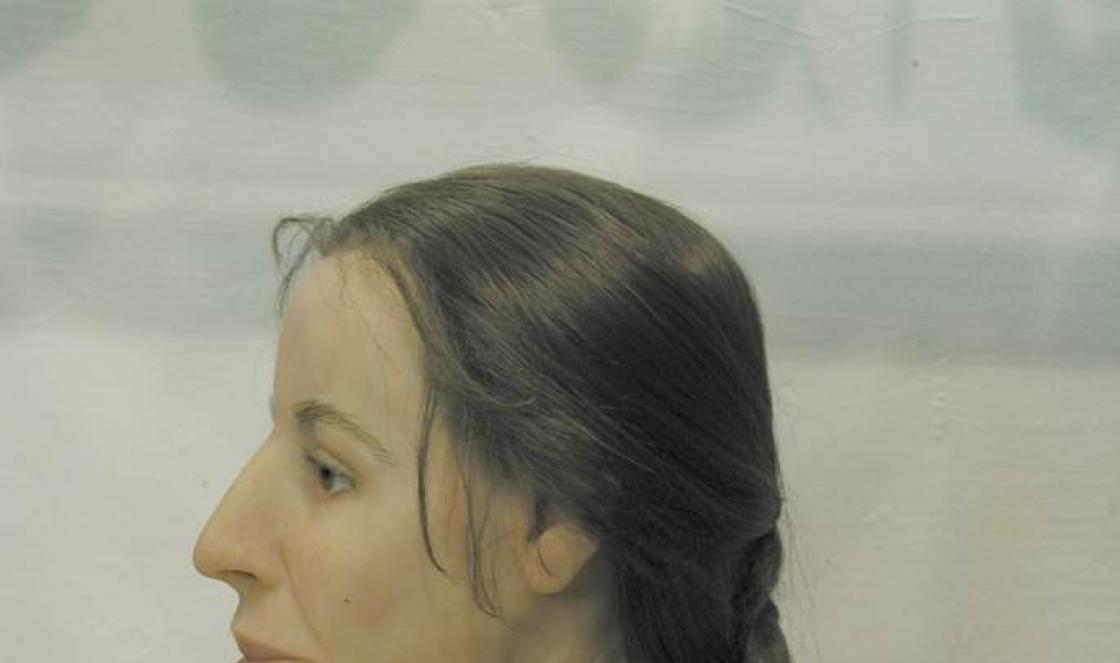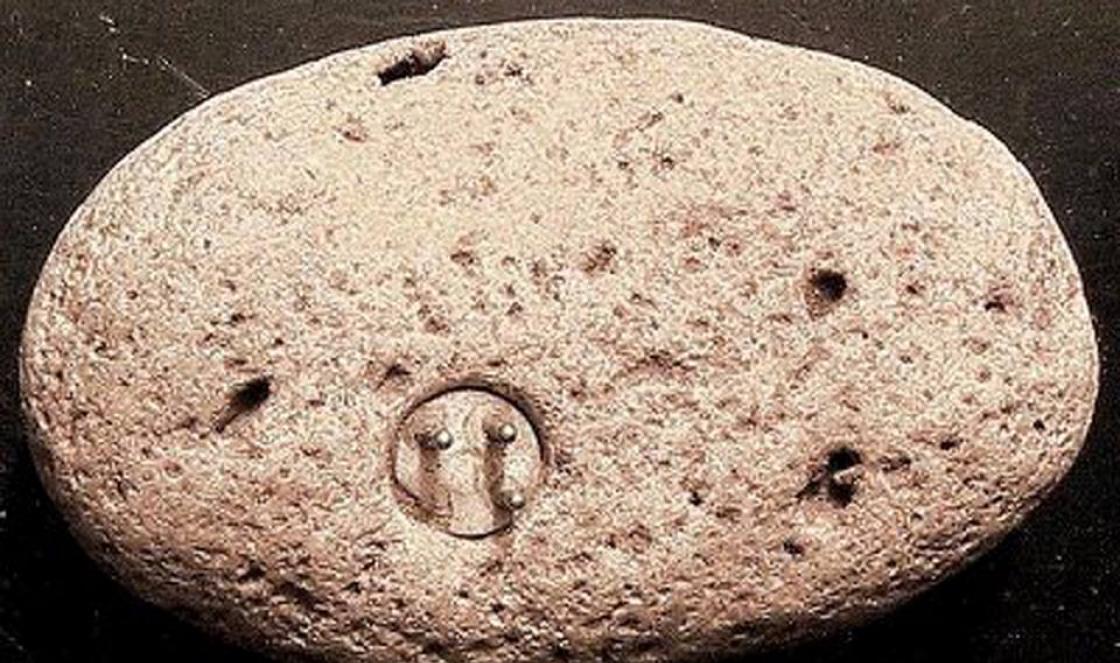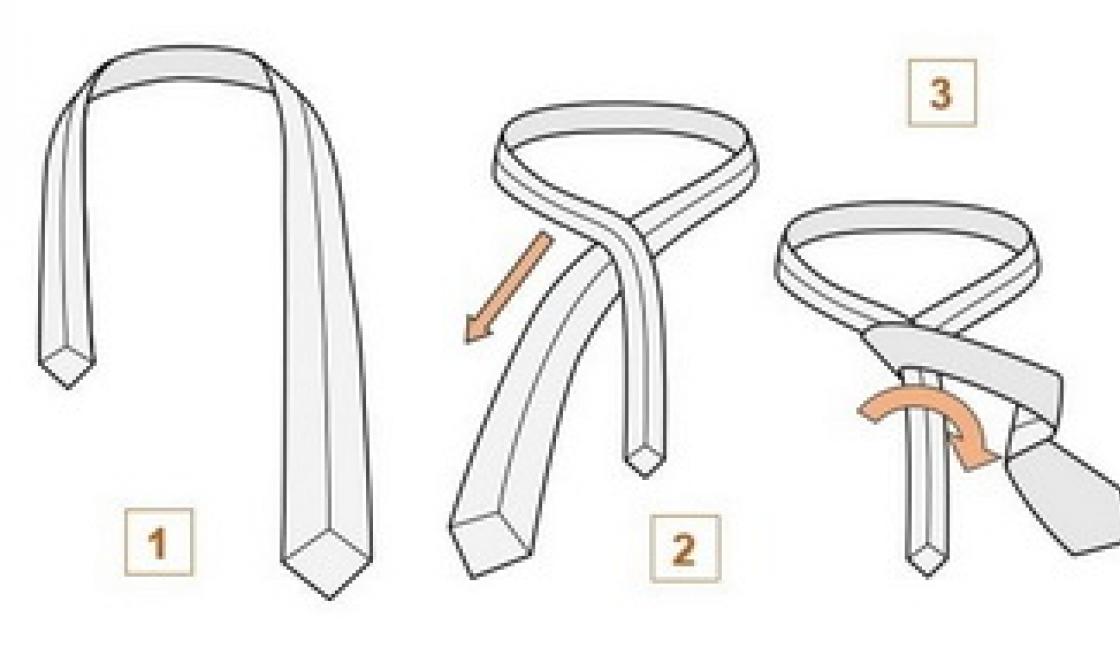A venous trophic ulcer is a long-term non-healing tissue defect that occurs when there is a severe violation of the venous outflow through the deep and superficial veins. The development of a trophic ulcer can be facilitated by extensive skin damage, burns, frostbite, chemical and radiation damage. Metabolic diseases, connective tissue diseases, blood diseases, infections can be complicated by the formation of trophic ulcers. Attention! All procedures for the treatment of trophic ulcers must be discussed with your doctor!
Treatment of trophic ulcers folk remedies:
Garlic with apple cider vinegar is an excellent remedy for the treatment of trophic ulcers.
For the treatment of trophic ulcers, use the following recipe: peel 3-4 cloves of garlic, pour 3 cups of apple cider vinegar, leave for 2 weeks - and the medicine is ready. It is also easy to use it for treatment: moisten a piece of cotton cloth with garlic vinegar, squeeze out excess liquid and apply directly to the sore spot. Secure the compress with a bandage and leave overnight, and apply a new compress in the morning. Ulcers do not completely go away, but they dry up, decrease, stop hurting, do not bother like before.
from trophic ulcers.
With trophic ulcers If you have kombucha, attach a piece to the sore spot, cover with sterile gauze and parchment on top. The fungus draws out pus, cleanses the wound. Do this for a week before bed. Should help. But in no case do not use polyethylene or cellophane - they do not let air through to the sore spot.
A mixture of trophic ulcers.
In the treatment of trophic ulcers, take 1 des. l. potato starch and 1/4 coffee l. citric acid, pour 50 ml of cold boiled water. Stir the mixture and pour into 150 ml of: boiling water, mix. As soon as the jelly thickens, remove from the stove and pour 2 tbsp. l. ground cudweed. Infuse for 2 hours and then add 1 tsp to the liquid. five percent iodine. Rinse the ulcer with furatsilin, dry with a gauze cloth. Apply 1 layer of gauze to the ulcer, and the prepared medicinal mixture on top. Bandage. Such dressings should be done within a week 3-4 times a day (make sure that the mass does not dry out). But for the whole night a bandage is applied only once, and in the morning you should wash the wound and apply fresh ointment. During such procedures, it is imperative to take an infusion of cudweed inside (2 tablespoons per 1 glass of water, insist until cool, drink 1/3 cup 3 times a day) - this is necessary to cleanse the body from the inside. Long-term healing ulcers will be defeated.
For the treatment of trophic ulcers, use the following remedies:
- 2 g of novocaine (preferably dry) is mixed with 1 teaspoon of fish oil, 10 g of honey and a vial of penicillin. The composition is applied to the sore spot and secured with a bandage. Change the bandage every 2 days. The course of treatment is 3 weeks.
- 0.5 kg of onion, pre-cut, calcined in a pan until brown, add a little cognac so that the gruel is wet. The fried onion is then dried and ground into a powder. This powder, mixed with vegetable oil, is applied to the open ulcerated surface. Do this 2 times a day until the ulcer heals.
- Grated raw pumpkin (pulp) on a gauze napkin or grated raw potato is applied to the affected areas of the skin for 30-40 minutes.
- 100 g of dry crushed meadowsweet leaves pour 0.5 liters of vodka, let it brew in a dark place for 2 weeks, shaking the contents periodically, strain. The tool is used to treat ulcers and compresses.
- Trophic ulcers can be lubricated with a solution of alum (In 100 ml of water, stir alum powder on the tip of a knife).
- Take 3 vials of castor oil, pour them into an enamel cup, put 5 g of ichthyol ointment and a crushed streptocide tablet there. Put the mixture in a water bath, warm up. Rinse the wound with hydrogen peroxide. Apply the cooled mixture to a sterile napkin, attach to the wound, tie with a bandage. Do the procedure 1 time per day. The results are amazing - after 2-3 weeks, the ulcers heal.
- Take purple paper and 5 boxes of matches. Rub the paper well on both sides with match grey. Then burn the paper. Treat the wound with hydrogen peroxide and sprinkle with ashes. Bandage after 2 hours. Do this daily for a week and the ulcer will heal.
- Take a glass of milk, a glass of granulated sugar, ½ piece baby soap, grated on a fine grater. Mix all the ingredients and boil them over low heat, stirring constantly. Allow to cool slightly and add one tube of heparin ointment to the warm mixture, mix thoroughly.
Warm up 1 tbsp. ointment, put it on gauze, put it on the ulcer, put cellophane on top and bandage it for a day. Then wash off the ointment with serum and re-bandage. Carry out the procedures daily until the ointment runs out. If the ulcer is large, repeat the treatment.
Effective remedies for the treatment of a long-term non-healing trophic ulcer
- Peel the ripe walnuts, burn the shells and partitions, sprinkle the ulcers with the resulting ash (wash the wounds with hydrogen peroxide or tincture of the golden mustache in advance), and they will soon heal. Pass the kernels of nuts through a meat grinder and fill them with olive or vegetable oil (sunflower) 2 fingers above the nuts themselves. Leave in a warm, dark place for 2 weeks, shaking 2-3 times a day. The resulting oil should be rubbed into protracted ulcers.
- Mix egg white with honey in equal proportions (1: 1), beat well and spread on long-term non-healing sores, as well as diseased veins. Then cover the problem area with three burdock leaves, wrap. film, bandage. This procedure should be done at night for 8 days in a row.
- You can make an ointment from wax, pine resin, vegetable and butter, and propolis. The recipe and technology for preparing the ointment are as follows: you need to take 1 tsp with a top of crushed wax, propolis, resin, 2 tablespoons vegetable oil, 50 g butter. Place everything in an enamel pan. Put on the smallest fire and keep stirring with a spoon until all the components are completely dissolved (with high heat, the mixture may flare up right in the pan). Prepare a jar, cover it with a bandage folded in four layers. Strain the finished hot mixture into a jar. The ointment should have a normal consistency.
Wash the wound before applying the ointment. Put the ointment on a bandage, attach it to the wound at night and walk like this for a day. After that, change the bandage and continue the treatment again. The recipe works well, tested many times - From trophic ulcers try Professor A. P. Voytenko's pasta. It consists of 100 g of gelatin and zinc oxide, 600 g of glycerin and 200 ml of distilled water. The pharmacy will help prepare the pasta. Before use, it must be heated in a water bath. A bandage with paste is applied immediately for 2 to 3 weeks, daily adding a small portion of the product. However, this basta does not cure ulcers in diabetic patients.
- Ulcers can be treated with the veterinary drug ASD-3. But before applying this liquid, you must first apply a disinfectant dressing to the wound for 2 hours, alternating a solution of furacilin, potassium permanganate and saline solution(1 tsp per glass of water). Treatment can last up to 5-6 months.
- You can use powders of a mixture of streptocide and penicillin: Take these drugs equally, mix and grind with a spoon on clean paper into a fine powder. Then apply the powder on the wound, tie with a bandage. So do at night, You can do it 2 times a day, it's very effective medicine. The powder instantly tightens the wound, it can be added to the cream and lubricate the wounds.
Leaves from trophic ulcers.
When treating trophic ulcers, try applying fresh, well-washed or steamed strawberry leaves to the ulcers 1-2 times a day. Take fresh yarrow juice (1/3 cup each) with honey (add to taste). Course - 3 weeks, 3 times a day
from trophic ulcers.
For external use with trophic ulcers, sleepy lichen will help. It grows on the trunks or on the branches of coniferous trees in the form of a kind of beard. Many people saw these green and gray beards in the forest, but never attached importance to them: take 2-3 tsp. raw materials for 1 tbsp. boiling water, insist under the lid for about 2 hours, strain. Soak a washcloth in the infusion, squeeze lightly and apply to the sore spot. Apply a waterproof material over it and bandage it. Change a cloth napkin soaked in infusion every 3 hours. Before going to bed, apply a napkin all night.
from trophic ulcers.
For trophic ulcers, try, after treating them with hydrogen peroxide, apply potassium permanganate soaked for an hour in a pink solution and cut along aloe leaves. Having laid them tightly, cover them with a film, also rubbed with peroxide, and bandage them. Do this procedure once a day for 5 days in a row. After this time, the scabs of the ulcers should fall off, leaving deep dents, which will also soon pass.
- an excellent remedy for trophic ulcers.
Rinse a leaf of a golden mustache in warm water, then tear it into pieces (1-1.5 cm), put in an enamel cup and knead with a wooden spoon so that the juice stands out and the pieces become wet. Put this mass on the ulcer, covering it with a sterile gauze napkin, and cover it with a clean napkin on top, then bandage it. It is desirable to do this procedure at night. If a purulent crust appears, then there is no need to be afraid. Treat the ulcer with hydrogen peroxide. Be patient, it will hurt. After processing, again apply a mass of golden mustache to the problem area and bandage it. The ulcer will gradually heal.
Cabbage leaf from trophic ulcers.
Soak a cabbage leaf in sea buckthorn oil and apply to the ulcer. The next day the sheet will dry and will be like paper. Repeat this procedure until the ulcers disappear.
For nets and venous nodes on the legs, try the following remedy: Cabbage leaf, previously scalded with boiling water to soften, put in plastic bag put in the refrigerator for a day. On the second day before going to bed, rub undiluted Apple vinegar in the mesh area. After the skin is dry, take a cabbage leaf from the refrigerator and apply it to the affected areas, bandage it. Remove the sheet in the morning. Repeat the procedure every day. To avoid interruptions in treatment, freeze cabbage leaves ahead of time. After the procedures, the knots decrease, there is lightness in the legs, and the pain becomes dull.

From trophic ulcers.
from trophic ulcers.
For varicose veins, take an infusion of hazel (hazelnut): 1 tbsp. dry leaves pour 1 tbsp. boiling water, leave for four hours, strain and drink 0.5 tbsp. three times a day) and a decoction of dry crushed bark (1 tbsp).
For external treatment, use a fern: In the spring, pass the young leaves of the plant through a meat grinder, pour the resulting slurry with the same amount of vodka, put it in the sun for six days, then strain. Soak a linen cloth in tincture and wipe your feet easily.
from trophic ulcers.
Freshly grated comfrey root can be applied to ulcers until they disappear.
from trophic ulcers.
You can alcohol tincture of calendula or 1 tbsp. grind a spoonful of crushed calendula flowers with 25 g of petroleum jelly and apply the resulting ointment to the affected areas.
cure trophic ulcers.
With the help of veselka tincture (the recipe in the section, you can treat trophic ulcers. To do this, you need to apply a bandage soaked in veselka tincture on the wound daily. The treatment is long, but successful, the ulcer heals without a trace.
With trophic ulcers, tomatoes will help.
For treatment, fresh tomatoes are needed. They must taste sour! Sweet or unleavened tomatoes won't do much good. It is best if they are freshly picked. Then their action will be accelerated. Tomatoes should be cut into pieces and applied to the ulcer with a cut. Then fasten with a bandage and walk with this compress for a day. Compresses must be changed in the morning. It will take a long time to heal, about 2 months. During this time, you can get rid of the disease completely. After the ulcer, there will be no traces left.
This prescription for the treatment of trophic ulcers is simply unique.
Take 20-25 g of fresh propolis and a pack of butter. Grind propolis on clean paper, put the oil in an enamel saucepan and heat over low heat. When it begins to boil, slowly sprinkle propolis over the entire surface of the oil, close the contents with a lid and do not remove it for 12 minutes. If it boils too much, then lift the pan and drive it in circles over the fire. Thus, the mass is well mixed and warmed up. Then remove the pan from the heat, strain the contents into a jar through cheesecloth, folded in three layers. After cooling, the ointment is ready. Close the jar with a lid and store the medicine in the refrigerator. Cut the napkins from the bandage, fold it into three layers, apply a little ointment on the napkin, put it on the wound, cover with a plastic bag and leave the compress for a day. Do the procedure daily until recovery. During treatment, you need to wipe the skin around the ulcer with hydrogen peroxide every other day. If the ulcer is large, then put a few napkins on the wound to close it completely. The result of the treatment will not be long in coming.
From skin itching with varicose veins
An alcohol tincture of celandine will help (20 drops per 1 tablespoon of milk) 3 times a day before meals. Tincture recipe: pour a small amount of fresh grass and flowers with alcohol or vodka so that the alcohol only covers the raw material, leave for 7 days, then strain. Start taking the tincture with 20 drops, adding 1 drop daily, and bring the amount to 50. The medicine is drunk 1 time per day. From 50 drops, you need to return to 20 again, reducing the dose by 1 drop daily, and finish the course of treatment. If necessary, after 15 days, the tincture can be repeated. Make lotions and compresses with an infusion of celandine herbs and after 2-3 days the itching will disappear.
For the treatment of trophic ulcers, you can try the following recipes
- Melt 200 g of fresh unsalted lard in a steam bath. Then 2 wax church candles, finely chopped (light), melt for a couple and combine with lard. Strain the resulting mass, cool. Then pour in a quarter cup of fir oil and the same amount of melted pine resin. Cut more sterile gauze wipes, dip them in the ointment so that they are soaked, put the medicine in the refrigerator. Make compresses in this way: put a napkin soaked in ointment on a sore spot, wrap the ulcer with cellophane on top and bandage it. After 12 hours, the napkin must be changed to another. The course of treatment is a month.
- Wash fresh cabbage leaves laundry soap and put on a sore spot, bandage. Before putting the cabbage, sprinkle the ulcer with streptocide, wipe it with tincture of calendula. Do this cabbage leaf bandage 2 times a day. When the cabbage leaf stops getting wet, then the ulcer heals. The course of treatment - 2-3 months
- In equal parts, take beeswax, lard, lamp oil, 0.5 h. spoons of birch tar, 1 teaspoon of honey. Mix everything and boil for 10 minutes. Use the ointment in a cooled form. It is applied to a bandage and dressings are made on the wound, changing them every two hours. Already by the evening of the first day, the ulcer is cleared, and on the third day it closes completely.
- 1 st. mix a spoonful of sheep or goat fat with 2 teaspoons of salt, add chopped onion, then rub everything through a sieve, put it on a clean bandage and bandage the wound for a day. At first, pain and burning will be felt, but gradually the ulcer will clear and become easier. Every day you need to change the bandage, replacing the composition with a fresh mass.
- Grind 200 g of eucalyptus leaves, put in a bottle, pour 0.5 cups of purified vegetable oil, add 2 chopped garlic cloves. Infuse for a week, strain. Soak a napkin with this composition and apply to the fistula 2 times a day for 30-40 minutes.
Rhubarb root will cure a trophic ulcer
Grate the rhubarb root on a fine grater, sift through a sieve and sprinkle the resulting powder on the ulcer, after lubricating it with fir oil.
If you have experienced this disease, you probably know how difficult it is to cope with it. This problem may not leave a person for a lifetime. You can’t do without a doctor’s consultation, and self-medication can lead to serious negative consequences in the form of complications. From this article, you will learn the treatment of a trophic leg ulcer at home, which can be quite effectively combined with medication.
What is the best way to treat a trophic ulcer on the leg
A trophic ulcer in the leg area is treated for a long time - it is difficult to treat at home, so you should be patient. It is important that the doctor controls the healing process. Most often, a similar disease is observed in the lower part of the tibia. As a result of the fact that stagnant processes in the blood are observed, and the skin is easily stretched, similar ulcers form. In order to heal them once and for all, it is important to establish the cause of the ulcer in the leg area.
At home, everyone can effectively deal with this disease. It is worth adhering to the basic rules:

If trophic ulcers are observed in the presence of varicose veins on the legs, special procedures must be performed every day:
- treatment with antiseptics;
- the use of creams, gels for tissue repair;
- taking anti-inflammatory drugs, antibiotics, vitamins, drugs to increase immunity.
If home treatment does not bring the expected results for a long time, you will most likely have to resort to surgical intervention. Refusing self-treatment, following all the doctor's recommendations, it is quite possible to get rid of a trophic ulcer without surgery.
Folk remedies for trophic ulcers on the leg

Preparations for the treatment of trophic ulcers
In order to treat a trophic ulcer on the leg in combination, medications are successfully used. These can be dressings and ointments, tablets and patches.
For oral administration, it is appropriate to use the following drugs:
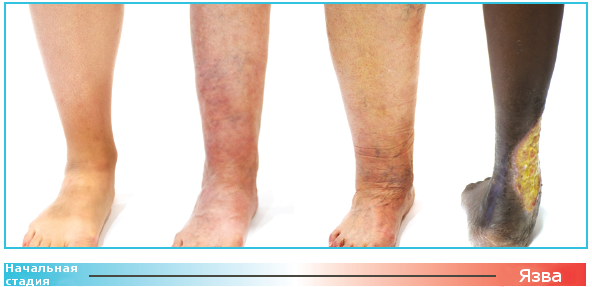
Bandages from trophic ulcers
Unna's bandage is effective in the fight against trophic ulcers. To prepare it, you should prepare a gelatin-glycerin mixture by adding zinc to it, as well as an elastic bandage. The bandage is applied to the lower leg - from the foot to the knee. The finished mixture is applied to the skin, after which it is wrapped with a layer of bandage, again covered with the mixture - already on top of it. The same should be done with other layers.
After a quarter of an hour, the bandage is lubricated with Formalin - this is how you manage to get rid of stickiness. It is necessary to walk with a bandage after three hours. After a month and a half, healing of the ulcer is observed.
Ointments for trophic ulcers

Ointments for treatment should be used as follows:
- Antiseptics - Bioptin, Miramistin, Levomekol.
- Proteolytics - "Iruksol", "Proteks - TM".
- Venotonics - "Lawton", "Gepatrombin", "Hepton".
You can prepare an ointment based on honey. To do this, a tablespoon of honey is mixed with fresh chicken protein. Then the remedy is infused for three hours. Before applying the ointment, the wound should be treated. To do this, use hydrogen peroxide and chamomile decoction.
Any treatment at home must be without fail agreed with the doctor. In the event that any prescription does not help, no need to worry. Try other ways that work.
Gels
To combat the disease, local gels based on "Heparin" are successfully used. Allergy and side effects excluded. From best gels it is worth highlighting "Lyoton", "Trombless", as well as "Trombofob".
is a long non-healing deep wound on the surface of the skin or mucous membrane. This lesion develops due to the rejection of dead tissue. Tissue death occurs due to their malnutrition, which occurs against the background of concomitant pathologies. As a rule, trophic ulcers occur against the background of diabetes mellitus, with arterial and neuralgic diseases, as well as with venous ailments. Their feature is that they do not lend themselves to healing for a very long time. A deep wound can disturb the patient for months and even years.
 Trophic ulcer lower limb
Trophic ulcer lower limb Trophic ulcers can occur in absolutely any place of the human body, but wounds on the legs are most often observed. If we talk about the development of deep non-healing wounds lower extremities, then the main reasons for their occurrence are:
- violations of the movement of blood through the vessels of the arterial, venous or lymphatic systems;
- mechanical injuries of the skin of the extremities;
- damage to soft tissues, as well as peripheral nerves.
Such ulcers are formed, as a rule, on the lower part of the leg - the lower leg or foot. Its development indicates the presence of concomitant problems in the human body.
According to official data, the most common cause of trophic ulcers on the lower extremities (legs) are: varicose veins (varicose veins), thrombosis, thrombophlebitis and other related diseases. Violation of blood circulation in these vascular diseases leads to the fact that the tissues do not receive enough necessary substances, their nutrition is disturbed. As a result, there is a gradual death (necrosis) of tissues and the formation of deep trophic ulcers on the legs. Such deep wounds are a favorable place for the spread and reproduction of pathological microorganisms, bacteria. This condition should be treated immediately.
 Blood flow disorders
Blood flow disorders Symptoms of the disease
As mentioned earlier, long-term non-healing wounds often form on the lower extremities. The presence of trophic ulcers on the legs most likely indicates a violation of blood circulation in this place, for example, with varicose veins. We bring to your attention the main symptoms that each person should pay attention to:
- pale smooth surface of the damaged part of the skin;
- thinning of the skin in a certain place, its dryness;
- bloody or purulent discharge from a wound on the leg;
- bad smell formed ulcer;
- feeling of coldness in the legs;
- painful sensations.
A deep non-healing wound on the legs can be completely different size, circles, have a curve or a smooth contour. The development of the disease makes itself felt in advance by changing the skin, after which a small sore is formed, which eventually turns into a real deep wound.
A feature of such skin lesions is their tendency to expand and increase, as well as the development of relapse.
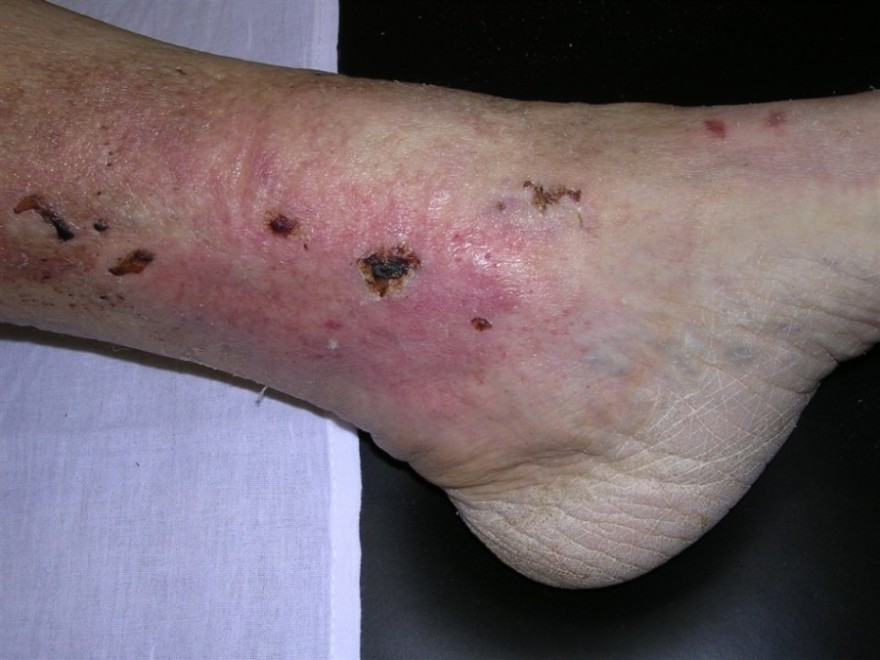 Symptoms of a trophic ulcer
Symptoms of a trophic ulcer How is this disease treated?
Therapy of this unpleasant disease requires considerable effort and a long time. A trophic ulcer on the leg can be treated with various medications in combination with folk remedies. As a rule, treatment takes place at home and does not require hospitalization. However, in particularly difficult cases with acute neglect of the disease, it may be necessary to be on an outpatient basis.
To properly treat trophic wounds, you need to know the causes of the development of the disease. If injuries have formed on the legs, the factors that contributed to their occurrence should be determined.
Most likely, disturbances in the circulation of the legs, the formation of blood clots, or the presence of an inflammatory process will be detected. Based on this, a complex treatment will be prescribed based on the normalization of blood flow, resorption of blood clots, etc. Such treatment can be not only conservative, but also surgical, depending on the complexity of the course of the disease. Only after the underlying disease has been cured can one begin to treat its consequences.
The main directions in the treatment of deep wounds are the daily dressing of the injured limb with the help of special dressings, as well as the careful treatment of ulcers with various antiseptic agents. Even with strict adherence to all the doctor's recommendations during the treatment of this disease, you should not expect a quick effect. Deep wounds that occur against the background of circulatory disorders tend not to heal for a long time and often recur.
Therapy with natural remedies
Trophic wounds can also be treated with folk remedies based on natural ingredients as an auxiliary method of treatment. It is unlikely that this disease can be cured exclusively by traditional medicine.
In addition, in some cases, you can even harm the patient even more. To achieve a stable long-term result is possible only in conjunction with drugs. Since modern doctors do not really like such therapy, the treatment of deep non-healing skin lesions on the leg with folk remedies is carried out at home under the guidance of the patient himself.
In order to quickly cure the resulting ulcer on the leg, it is necessary to carry out all procedures at home under the most comfortable conditions for the patient. For the treatment of this ailment, such traditional medicine is used:
- You can treat the disease with hydrogen peroxide, egg oil and Kalanchoe leaves. First, treat the wound on the leg and the area around it with peroxide, and then apply separately prepared egg oil, which is made from hard-boiled yolks and sunflower oil. Then a sheet of Kalanchoe, previously cleared of the upper film, is applied, the sore leg is bandaged. Such a remedy will help cure an ulcer in the shortest possible time.
 Treatment of trophic ulcers with hydrogen peroxide
Treatment of trophic ulcers with hydrogen peroxide - with the help of yogurt and cottage cheese. Use half a liter of homemade milk, ferment it and separate curdled curd from whey. First, the wound is washed with serum, then the curd mass is applied to it, the leg is bandaged and left overnight. This method will help to quickly cure ulcerative skin lesions at home.
- This ailment can also be cured with hydrogen peroxide and streptocide. First, rinse the wound with peroxide, and then cover it with streptocide powder, tightly wrap it with a bandage and provide warmth to the sore spot, for example, by bandaging it with a warm scarf or scarf. Such a compress will be an excellent assistant for the treatment of trophic ulcers.
- Vegetable oil after ordinary frying for soup will help treat trophic ulcers of the lower extremities. Finely chopped and peeled onions, as well as grated carrots, are fried over low heat with the addition of sunflower oil. After the vegetables are cooked, the resulting oil is drained, cooled and lubricated with wounds.
- A leaf of white cabbage will help get rid of lesions on the skin of the legs. Before applying a sheet to a sore spot, it should be moistened in sea buckthorn oil, then pressed against the wound and wrapped. Such a compress is kept for a day, after which it is changed to a new one.
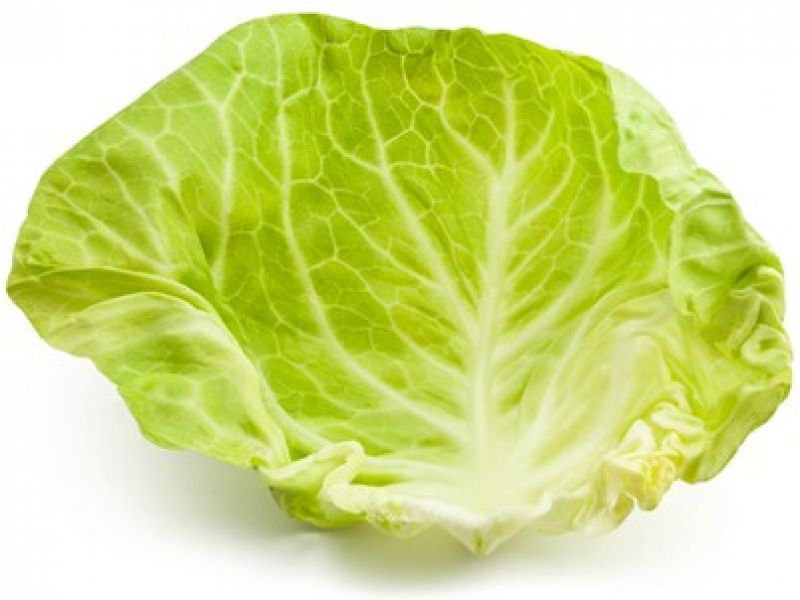 Compress from a cabbage leaf with a trophic ulcer
Compress from a cabbage leaf with a trophic ulcer We have given recipes for the most common folk remedies intended for the treatment of skin ulcers at home. Before you begin to treat your disease, be sure to consult a doctor in order to avoid worsening the course of the disease. Only a doctor can allow or prohibit the treatment of trophic ulcers on the legs with folk remedies.
A trophic ulcer will not arise on its own, it always has a cause that should be found first.
Causes the occurrence of trophic ulcers of the lower extremities can be: venous insufficiency (thrombophlebitis), narrowing of the lumen of the arteries (atherosclerosis, diabetes mellitus, hypertension), impaired lymph outflow (elephantiasis), decreased tissue sensitivity (fractures, bruises, burns, frostbite), chronic skin diseases (eczema).
With thrombophlebitis (the most common cause), a trophic ulcer usually appears on the inner and outer surface of the lower third of the leg, with atherosclerosis - in the heel area, on the foot and big toe, with diabetes - at the ends of the toes, with hypertension - symmetrically on both sides legs and is highly painful.
Treatment of the underlying disease is the first step towards the eradication of a trophic ulcer. It is advisable to do an ultrasound and x-ray blood vessels, rheovasography (study of blood supply to organs and the state of peripheral vessels).
Before starting the treatment of the ulcer itself, it is necessary to pass an analysis to determine the nature of the microflora and pass an antibiotic sensitivity test.
Enzymes (chymopsin, trypsin) are used to cleanse the wound, ointments (kombutek, solcoseryl, actovegin) are used for healing, and vasoprotectors are used to improve blood flow.
In difficult cases, trophic ulcers are treated promptly. With thrombophlebitis, obstructed sections of the veins are removed, with atherosclerosis, bypass shunting is performed (implantation of vessel-implants in the artery). More modern, but expensive methods of treating ulcers are laser coagulation (restoration of blood flow to the veins using a laser) and foam sclerotherapy (gluing the veins with special foam under ultrasound control).
Folk remedies for trophic ulcers
From folk ways treatments for washing a trophic ulcer help well infusions celandine, comfrey (1 tablespoon of herbs per cup of boiling water), garlic water, Kombucha infusion, decoctions of oak bark and horsetail (1.5 tablespoons per cup of boiling water).
For disinfection, it is useful to irrigate the wound with aloe juice, Kalanchoe, plantain, burdock (alternate them after 7 days).
At night you can tie to the wound birch cakes from 1 part of honey and 2 parts of birch buds, scrolled through a meat grinder. Compresses with birch ash (100 g per 1 liter of boiling water), mummy (10 g per 100 g of liquid honey), raw potatoes, and baked onions also contribute to the healing of trophic ulcers.
Try the ointment for a trophic ulcer: 3 vials of castor oil, 5 g of ichthyol ointment, simmer a streptocide tablet in a water bath until the mixture becomes liquid (change the bandage 1 time per day).
Therapeutic patch for trophic ulcers.
Try this healing patch: 20 g of combustible sulfur, 2 medium onions, 50 g of butter (preferably homemade), 15 g of spruce resin, 70 g of wax. Everything needs to be crushed and crushed in a mortar. Dip a linen cloth (according to the size of the wound) into the composition and apply to the sore spot, leave for 2-3 days, then change the “patch”. After the first time, you will notice an improvement.
Recipe for leg ulcers.
In autumn, dig up 2-3 celandine bushes along with the roots. Peel off dry leaves, wash and dry overnight on paper. In the morning, break the celandine, put it in an enamel bowl, pour 1.5 cups of unrefined sunflower oil and drown with a wooden stick. Bring to a boil and immediately remove from the stove. Wrap the pan well for 12 hours! Then carefully strain, squeezing out the raw materials. Pour the oil into a bottle and refrigerate. If necessary, lubricate damaged skin 1-2 times a day.
Natural remedies to cure hard-to-heal ulcers
- Apply a thin layer of grated raw potatoes to the affected areas of the skin for half an hour. Then rinse with warm water. Do the procedure 2 times a day.
- Mix freshly prepared black radish juice with vegetable oil in a ratio of 2: 1 and rub into problem areas once a day.
You can combine black radish juice with vodka and honey in a ratio of 1:1:1/2 and also rub into ulcers once a day.
When you remove the bandage, wash the wounds with this composition: 1 tbsp. Pour a spoonful of quicklime with 2 liters of warm water, leave for 3-4 days. Remove the formed film from the surface of the liquid and use the infusion for washing.
Melt the resin of coniferous trees with natural milk and lubricate sore spots daily.
Fold the gauze in 6-8 layers, soak in the solution and apply to the affected area
skin for 2 hours. Repeat this 2 times a day.
After applying birch infusion, wash the sore spots with the following composition: dissolve 40 drops of calendula tincture in a glass of cool boiled water. Then bandage the problem areas of the skin and repeat the procedure after 2-3 hours.
After 2-3 weeks of such treatment, any ulcer heals.
Oil can be stored without straining.
There is another way to prepare St. John's wort oil, but in the case of ulcers, this is how it should be prepared.
To 100 g of freshly prepared potato gruel, add 1 teaspoon of honey, mix thoroughly, apply a layer of at least 1 cm on a gauze napkin and apply to the ulcers, securing with a bandage.
After 2 hours, remove the bandage, carefully remove the mixture remaining on the skin with dry gauze. Repeat the procedure several times.
in a boiling water bath until a homogeneous consistency is formed, stirring with a wooden spatula, cool.
Use the ointment to treat poorly healing ulcers, as well as wounds and burns. Store the product in a dark, cool place.

Recipe for an agent acting on trophic ulcers.
This is a natural remedy for the treatment of trophic ulcers, all ingredients are available. The medicine is easy to prepare. To prepare it, you need physalis berries and eucalyptus leaves. Eucalyptus is sold in any pharmacy, it is not difficult to find it. Physalis is also grown by many. Now about the preparation of the medicine itself. You need to take 20 g of physalis berries and grind them. Pour physalis with 1 teaspoon of pure vegetable oil and leave for two days. When the oil is infused, prepare an infusion of eucalyptus. To do this, pour 50 g of eucalyptus leaves into 100 ml of boiling water and leave for a couple of hours. Add 2 teaspoons of eucalyptus extract to physalis oil. You will get a healing mixture. It doesn't need to be filtered. Apply this mixture to the affected area 2 times a day. This is a very strong wound healing agent. Tightens ulcers and wounds almost before our eyes. If your family has a similar problem, try this remedy.
With trophic ulcers, traditional medicine offers the following recipes.
Mix 60 g of unsalted goose or pork internal fat with 30 g of fir oil and 10 g of Vishnevsky's ointment, apply on sore skin areas, tie with a bandage. Change dressings 2-3 times a day, treat like this until recovery.
Rub the rhubarb root on a fine grater, sift through a fine sieve and sprinkle the prepared powder on the ulcer, after lubricating it with fir oil.
With trophic ulcers, severe itching and suppuration, it is very effective to soar the legs for 5-7 minutes in a strong solution of potassium permanganate (the solution should be cherry-colored. The course of treatment is a week.
Mix 1 part of fresh chicken eggs with 1 part of honey and apply this composition to sore spots overnight on a napkin. Put a burdock leaf on top reverse side, cover with cellophane and bandage until the morning.
Combine 1 part birch sap and 1 part vodka. Soak a cotton swab or napkin in this solution, apply to the wound, wrap with cellophane and secure with a bandage. 1 st. mix a spoonful of honey with 1 tbsp. sunflower spoon unrefined oil, 1 tbsp. spoon of 20% alcohol tincture of propolis and lubricate the ulcers with this remedy. Clean the wound with a swab moistened with an isotonic solution, apply 2-3 sterile wipes, top with a sterile rubber sponge 1.5 cm thick (the sponge draws everything bad out of the wound, and as a result new healthy cells appear) and again 2-3 wipes. Bandage and do not remove the bandage for 3 days.
Repeat the treatment 2-3 times, more if possible.
Soak a napkin with birch tar, apply to a sore spot, cover with cellophane and bandage. Change bandages every 2 days.
Wash a fresh plantain leaf with boiled water, remember through a sterile napkin and apply to the ulcer, tightly securing with a bandage. After a day, remove the bandage, wash the wound with a 3% solution of hydrogen peroxide or a weak solution of potassium permanganate and apply psyllium again.
Pour 10 g of crushed comfrey roots with a glass of boiling water, cook over low heat for 10 minutes, strain and use a decoction for lotions.
Wash the wound with boiled water and dark laundry soap and apply a gauze dressing with St. John's wort oil overnight, securing with a bandage.
Excellent remedy for trophic ulcers
With trophic ulcers, first of all, wash the wounds with lime water: 1 tbsp. a spoonful of quicklime per 1 liter of water, then apply a bandage with one of the ointments:
1) 100 g of resin of spruce or pine, 100 g of beeswax, 100 g of lard, Boil this mixture, cool, lubricate the affected area.
2) 1 teaspoon of beeswax, 1 teaspoon of pork fat, 0.5 teaspoon of birch tar, 1 teaspoon of honey, 1 teaspoon of unctuous oil (lamp) - mix everything, lubricate the ulcers.
3) Infuse Sophora with vodka (1: 2) and apply napkins with this tincture on ulcers.
Trophic ulcers can be treated with this mixture
Mix 200 g of good butter with 10 vials of penicillin, 5 streptocide powders. Apply the mixture to a tissue and apply it to the affected area. Change the bandage once a day.
A mixture of pharmacy ointments treats trophic ulcers
To cure a trophic ulcer, mix pharmacy ointments: hyoxysone 0.1% - 1 tube (10 g); gentamicin 0.1% - 1 tube (15 g); sinaflan 0.025% - 1 tube (15 g); methyluracil 10% - 1 tube (25 g); 100 g of baby vaseline and 4 sachets of 2 g of streptocide powder. For 2.5 months of applying the ointment, the trophic ulcer will heal.
Whitehead will help cure a trophic ulcer
Take 2 tbsp. l. dry whitehead, pour 200 g of boiling water, insist from evening to morning. And then wash the ulcer with this solution 3-4 times during the day. After washing, the ulcer should be left open, not tied up and smeared with nothing else. Within a week, you can deal with this disaster.
Ash heals a trophic ulcer
A trophic ulcer begins to heal quickly if it is sprinkled several times a day with ashes from walnut shells.
A person is not immune from diseases, they can overtake him at any time and at any age. But you should not immediately run to the pharmacy at the first symptoms and start taking medication. Sometimes you can try treatment at home. True, I immediately want to make a reservation that this does not apply to all diseases, but be sure to listen to your body, and you will understand everything yourself. Now the conversation will be about how trophic ulcers are treated at home.
What is a trophic ulcer
This is a defect in the skin, mucous membrane, which occurs as a result of malnutrition of tissues. You should not joke with this disease, as it can lead to:
- eczema;
- suppuration;
- fungal infection;
- erysipelas;
- swelling of the skin and subcutaneous tissue;
- thrombophlebitis;
- inflammation of the periosteum;
- arthrosis of the ankle joint.
Ulcers have different shapes and sizes. The edge of the wound is always compacted, protrudes above the surface of the skin. The bottom of the ulcer is shallow and flat. There are almost no discharges, and if they do, they are scarce.
Causes of the disease
A trophic ulcer can occur as a result of pathology on the part of the blood circulation and on the part of damage to skin tissues, especially injuries.
Diseases that cause ulcers:
- atherosclerosis of the arteries of the lower extremities;
- and others ;
- inflammation of the lymph nodes;
- frostbite;
- burns;
- diabetes;
- chronic dermatitis;
- violation of blood flow in the lower extremities;
- damage to nerve trunks.
You should not joke with such a disease as a trophic ulcer. Patient reviews boil down to the fact that only timely treatment can give positive result. After all, this ailment often appears after complications resulting from diseases such as varicose veins and thrombophlebitis. Venous blood stagnates in small veins, thereby violating the tone of the capillaries. The most severe are ulcers caused by diabetes mellitus. It is worth a little scratching, and pathology may begin.
Symptoms of a trophic ulcer
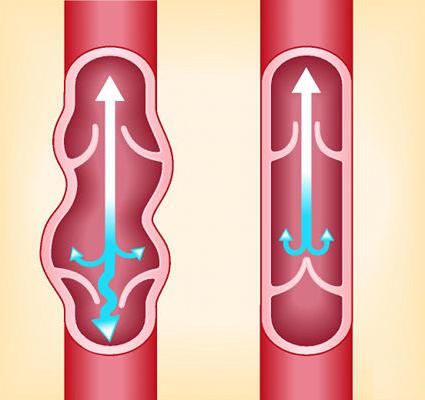
In order to start or immediately consult a doctor, you should know what symptoms precede this disease:
- soreness;
- puffiness;
- constant heaviness in the legs;
- burning skin;
- frequent night cramps;
- there is a modification of the skin, it becomes tense with a purple tint, sometimes purple spots appear, the skin becomes rough, it hurts when touched.
These symptoms have a trophic ulcer of the leg, treatment can only be prescribed by a specialist. There are also homemade recipes, but for the fastest healing you have to go through a lot of procedures. Fortunately, a large number of folk remedies are known to help cope with the disease. We will return to this topic later.
Venous ulcers
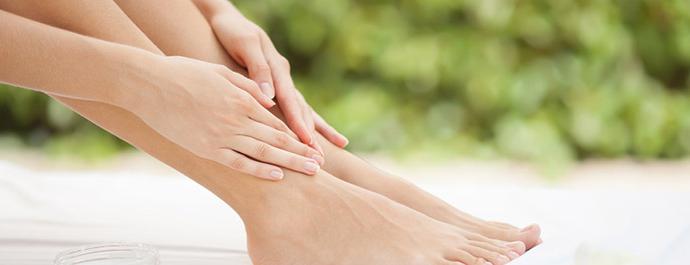 A trophic ulcer of the foot and lower leg is the result of a complication of a neurovascular disease of the lower extremities. Most often it develops on the lower leg. Appears in violation of the venous blood flow of the lower extremities and as a complication of varicose veins. The following symptoms appear that precede the appearance of wounds:
A trophic ulcer of the foot and lower leg is the result of a complication of a neurovascular disease of the lower extremities. Most often it develops on the lower leg. Appears in violation of the venous blood flow of the lower extremities and as a complication of varicose veins. The following symptoms appear that precede the appearance of wounds:
- swelling of the calf parts;
- heaviness in the legs;
- convulsions appear at night;
- veins appear on the limbs, which eventually turn purple;
- the skin thickens;
- clamps appear, which are very similar to flakes.
If at this very moment you do not start treatment, then you will have trophic varicose ulcers on your limbs. They have an unpleasant smell, and pus is released from them.
Four stages of the course of the disease

The first phase is an ulcer in the progression stage. At this stage, it is necessary to stop its development. For this, drugs are used that improve tissue nutrition, which promotes wound healing.
The second phase is the cleansing of the trophic ulcer. There is a surgical treatment of the ulcer. Only after this procedure can local preparations be applied to the wound. Thanks to them, a trophic ulcer can move to the next phase.
The third phase is granulation. There is scarring of the wound. Local and general treatment drugs are used.
The fourth phase is complete healing. This period is the most dangerous. Something must be done wrong, and healing may stop and return to the first phase again.
Treatment at home
Treatment of trophic ulcers at home is possible and effective. There are a huge number of healing methods, now we will talk about some of them. Just remember that the conditions must be sterile so that pathogenic microbes do not get into the wound. 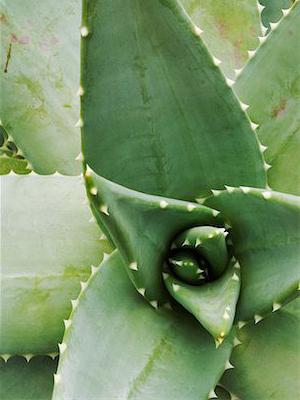
- Take the same amount of honey and egg white, beat everything well. Using a cotton swab, apply the mixture to the ulcer. Wrap the leg with the back of the burdock, with a film and tightly bandage it, leave it overnight. The procedure is done from five to ten days.
- Apply hydrogen peroxide to the ulcer. Wait for it to dry out a bit. After that, sprinkle with streptocide. Put a napkin soaked in boiled water on top. Wrap your leg in cellophane, apply a warm bandage. Dressing is done two to three times a day. Streptocid streptocide immediately, as soon as the wound became wet.
- You will need a tablespoon and one boiled egg yolk. Mix the ingredients, fry in a pan. The mass that has turned out is squeezed through a cotton cloth. Wash the wound with hydrogen peroxide, apply the resulting ointment on it and put a leaf of kalonchoe. Before putting the leaf on the wound, wash it with boiling water and remove the film from it. Bandage your leg. The procedure is done in the morning and in the evening for two months.
- If you can find such a plant, use it to treat ulcers as well. Cut the leaves of the plant, previously washed in boiled water, into small pieces. Knead it until the juice comes out. Apply the resulting mass to the wound, cover with a napkin and fix with a bandage.
Disease prevention
A trophic ulcer is a disease that can “return” to you at any time. In order to prevent this from happening, you will have to carry out preventive treatment at least twice a year. Be sure to monitor the condition of the blood vessels. Places where there were ulcers, periodically lubricate with oil, which is infused with St. John's wort and calendula. Try not to put too much stress on your legs. Perform exercises that increase the elasticity of blood vessels. 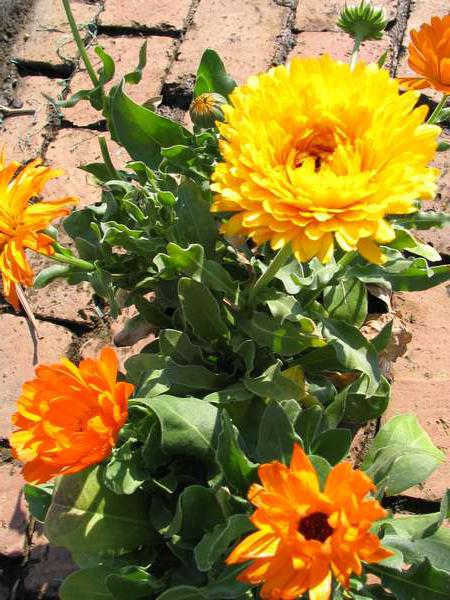
Conclusion
Treatment of trophic ulcers at home will require a lot of patience from you. After all, this disease cannot be cured in one day, it will take a lot of time. Remember, no matter how difficult it is for you, do not interrupt the treatment in any case. Only after the specialist makes a diagnosis, you can proceed with the procedures.


